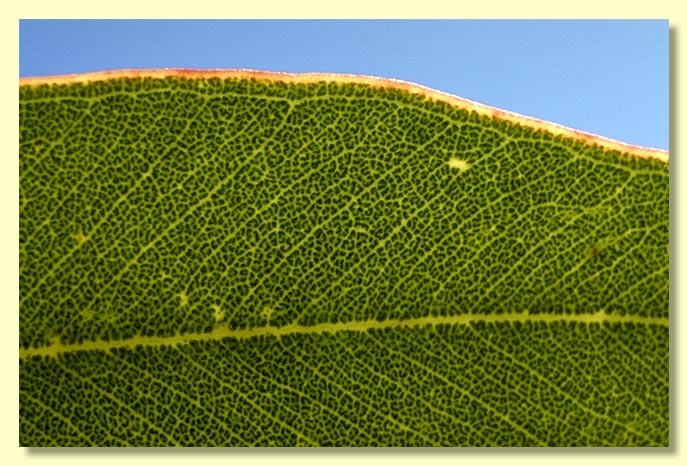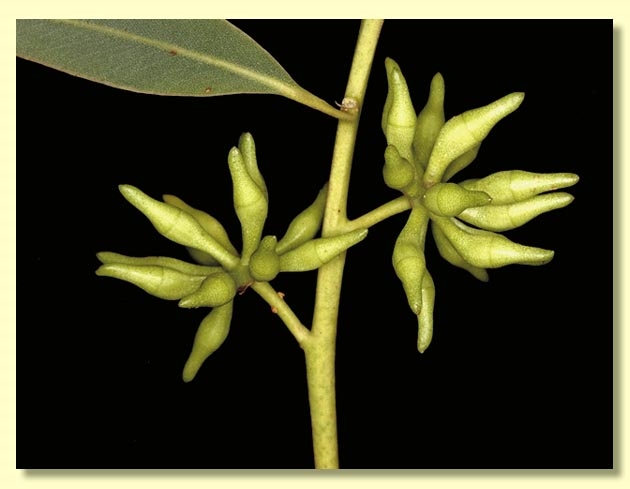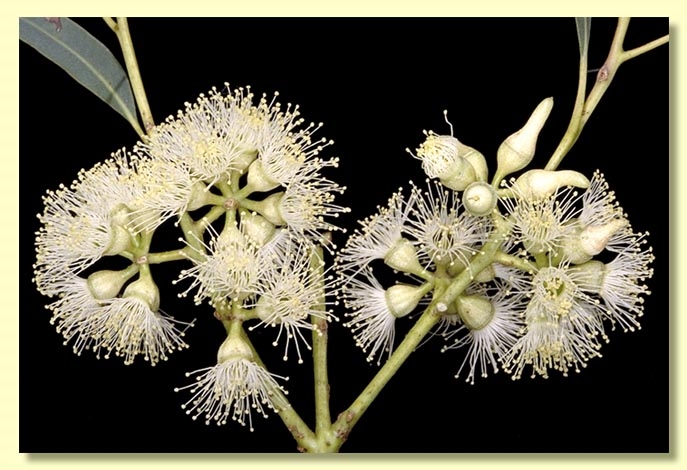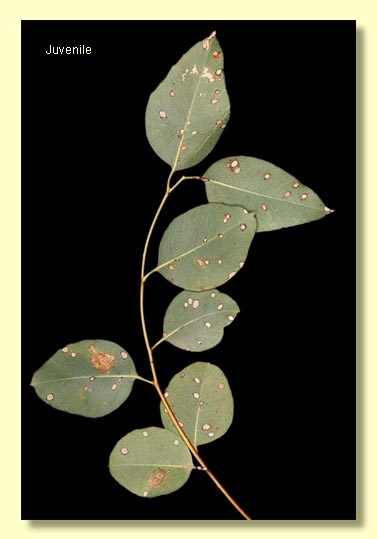Eucalyptus | Symphyomyrtus | Bisectae | Destitutae | Falcatae | Rugatae
Euclid - Online edition
Eucalyptus petrensis
Bark smooth throughout or on larger plants rough only at the base with some persistent ribbons, smooth bark pale grey and pale brown.
Branchlets lacking oil glands in the pith.
Juvenile stems rounded in cross-section; juvenile leaves always petiolate, opposite for lowest node only then alternate, ovate, 4.5–11 cm long, 3–5 cm wide, green to grey-green, dull.
Adult leaves alternate, petiole 0.8–2.5 cm long; blade lanceolate, (6)7–12.7 cm long, 1–2.8 cm wide, base tapering to petiole, margin entire, apex pointed, concolorous, mid-green, usually glossy, side-veins greater than 45° to midrib, reticulation dense, intramarginal vein close to margin, oil glands absent or obscure.
Inflorescence axillary unbranched, peduncles erect to spreading, 0.4–1.5 cm long, buds 9 to 15, pedicellate (pedicels 0.2–0.4 cm long). Mature buds ovoid (1–1.5 cm long, 0.4–0.6 cm wide), hypanthium ribbed or smooth, scar present (outer operculum shed early), operculum beaked, stamens inflexed, anthers cuboid, versatile, sub-basifixed, dehiscing by longitudinal slits, style long and straight, stigma more or less blunt, locules 3 or 4, the placentae each with 4 vertical rows of ovules. Flowers creamy white.
Fruit pedicellate (pedicels 0.2–0.4 cm long), usually truncate-globose, ribbed, wrinkled or smooth, 0.5–0.8 cm long, 0.7–1 cm wide, rim thick, disc descending vertically, valves 3 or 4, slender and prominently exserted but fragile.
Seeds grey-brown to brown, 1–2.5 mm long, ovoid or flattened-ovoid, dorsal surface smooth to very shallowly reticulate, hilum ventral.
Cultivated seedling: cotyledons Y-shaped (bisected); stems square to rounded in cross-section; leaves opposite for ca 9–11 nodes then alternate, sessile and linear to node 2 then becoming petiolate and narrowly elliptical then ovate, 2.5–7 cm long, 1.5–4 cm wide, base tapering, margin entire, apex rounded to acute, green to grey-green, dull.
Flowering has been recorded in April, June, September, October and November.
A sprawling mallee endemic to Western Australia, found in Yalgorup National Park south of Perth, north to Seabird and Wedge Island, on strictly coastal limestony sites. The stems are smooth, adult leaves slightly glossy green, umbels held more or less erect to spreading in the leaf axils, buds ribbed or almost smooth basally and with smooth beaked operculum.
In the classification of Brooker (2000) Eucalyptus petrensis belongs in Eucalyptus subgenus Symphyomyrtus section Bisectae subsection Destitutae because buds have two opercula, cotyledons are Y-shaped and branchlets lack oil glands in the pith. Within this subsection E. petrensis belongs to a group of species and subspecies most of which are characterised by down-turned or spreading inflorescences with pedicellate ovoid buds with a conical to beaked operculum, flattened to-truncate globose fruits with exserted fragile valves, and adult leaves that are green, densely reticulate and have numerous intersectional oil glands. This group is series Falcatae subseries Rugatae and has been considerably modified since Brooker's published classification. The species now included in subseries Rugatae are: the mallets E. falcata, E. ornata, E. purpurata, E. recta, E. rugulata and the recently described E. annettae, and the mallees E. dorrienii, E. petrensis, E. opimiflora, E. ecostata, plus E. goniantha (with 2 subspecies), E. semiglobosa, E. notactites, and E. kessellii (with 2 subspecies) .
Within subseries Rugatae the mallee E. petrensis differs from the mallet species mentioned above by its profoundly different growth habit.
Of the mallee species in subseries Rugatae, E. petrensis, is most similar to the recently described mallee E. opimiflora, a species occuring in the northern and central wheatbelt from Mingenew south to Cunderdin, which shares the erect to spreading (not pendulous) infloresence, but differs in having fatter buds with conical operculum (beaked operculum in E. petrensis). In the southern wheatbelt and adjacent foothills the mallee E. dorrienii occurs usually on rising ground and differs from E. petrensis by its distinctly pendulous umbels on longer slender peduncles, longer pedicels with more dilated hypanthia on the ribbed ovoid buds. Further south-east E. ecostata also has pendulous umbels, and further differs in its buds that are scarcely ribbed or are unribbed and have an elongated conical operculum.
The remaining mallee species in subseries Rugatae all occur in southern coastal or subcoastal areas, and differ from E. petrensis thus: E. goniantha (squared branchlets, flat peduncles, stout cream ovoid buds which are weakly ribbed or not ribbed, in 7s or 9s), E. notactites (squared or winged branchlets, flat peduncles, stout cream ovoid buds weakly ribbed, in 7s up to 19s), E. kessellii (broad flat short peduncles, stout cream ovoid ribbed buds in 3s or 7s), E. semiglobosa (pendulous umbels on slender scarcely flattened peduncles, cream rounded buds with rounded short operculum, not or weakly ribbed, in 7s, 9s or 11s).



















